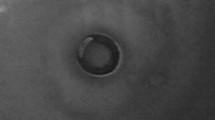Abstract
Discharge of waste containing heavy metals through anthropogenic activities has created global environmental and health burden and remediation of contaminated sites becomes more expensive, however sustainable methods of degrading heavy metals using resistant microorganisms have become important biotechnological development. 42 lead resistant bacteria were isolated from municipal solid waste in Tiruchirappalli. Lead resistant bacteria were screened and the maximum tolerable concentration was found to be in the range of 100–260 mg/kg. Lead resistant bacteria such as Pseudomonas spp., Klebsiella spp., Enterobacter spp., Escherichia spp. were identified and used to make consortium and used in column test. The results show lead diminishing from 0.923 to 0.1943 ppm concerning the control sample from day 1 until day 10. The consortium used has shown capability to biodegrade lead in solid waste and may further be used for biomining and other bioremediation studies.
Access this chapter
Tax calculation will be finalised at checkout
Purchases are for personal use only
Similar content being viewed by others
References
Ayyasamy PM, Lee S (2009) Redox transformation and biogeochemical interaction of heavy metals in Korean soil using different treatment columns in the presence of Shewanella sp. Chemosphere 77(4):501–509
Balint Nimirciag R, Buratto E, Ajmone-Marsan F (2013) Leaching of trace metals from soil under alternating oxic-anoxic conditions: a column study. In: E3S web of conferences, vol 1, p 19005
Bergey DH, Buchanan RE, Gibbons NE (1974) Bergey’s manual of determinative bacteriology. Williams & Wilkins, Baltimore
Bergey DH (1986) Bergey’s manual of systematic bacteriology, 1st edn, vol 2. The Williams & Wilkins Co., Baltimore
Hrynkiewicz K, Baum C (2014) Application of microorganisms in bioremediation of environment from heavy metals. Environ Deterioration Human Health 215–227
Malin B, Jarno M, Marja S, Mona A (2017) Microbial community structure and functions in ethanol-fed sulfate removal bioreactors for treatment of mine water. Microorganisms 5:61
Massadeh AM, Al-Momani FA, Haddad HI (2005) Removal of lead and cadmium by halophilic bacteria isolated from the dead sea shore, Jordan. Biol Trace Element Res 108(1–3):259–270
Moten AM, Rehman A (1998) Study on heavy trace metal ions in industrial waste effluents in Pakistan. Environ Exp Com Article 909
Rehman A, Zahoor A, Muneer B, Hasnain S (2008) Chromium tolerance and reduction potential of a Bacillus sp. ev3 isolated from metal contaminated wastewater. Bull Environ Contam Toxicol 81:25–29
Rojas LA, Yáñez C, González M, Lobos S, Smalla K, Seeger M (2011) Characterization of the metabolically modified heavy metal-resistant cupriavidus metallidurans strain MSR33 generated for mercury bioremediation. PLoS ONE 6(3):e17555
Tchounwou PB, Yedjou CG, Patlolla AK, Sutton DJ (2012) Heavy metal toxicity and the environment. Mol Clin Environ Toxicol 133–164
Thassitou P, Arvanitoyannis I (2001) Bioremediation: a novel approach to food waste management. Trends Food Sci Technol 12(5):185–196
U.S. EPA (1996) Method 3050B: acid digestion of sediments, sludges, and soils, Revision 2. Washington, DC
Yamina B, Tahar B, Marie Laure F (2012) Isolation and screening of heavy metal resistant bacteria from wastewater: a study of heavy metal co-resistance and antibiotics resistance. Water Sci Technol 66(10):2041–2048
Author information
Authors and Affiliations
Corresponding author
Editor information
Editors and Affiliations
Rights and permissions
Copyright information
© 2021 The Author(s), under exclusive license to Springer Nature Switzerland AG
About this chapter
Cite this chapter
Felix, M., Arjunan, M., Siddeshwar, K., Sundaram, R., Marimuthu, P. (2021). Biodegradation of Lead from Accumulated Municipal Solid Waste Using Bacterial Consortium for Effective Biomining. In: Marimuthu, P.D., Sundaram, R., Jeyaseelan, A., Kaliannan, T. (eds) Bioremediation and Green Technologies. Environmental Science and Engineering(). Springer, Cham. https://doi.org/10.1007/978-3-030-64122-1_8
Download citation
DOI: https://doi.org/10.1007/978-3-030-64122-1_8
Published:
Publisher Name: Springer, Cham
Print ISBN: 978-3-030-64121-4
Online ISBN: 978-3-030-64122-1
eBook Packages: Earth and Environmental ScienceEarth and Environmental Science (R0)




